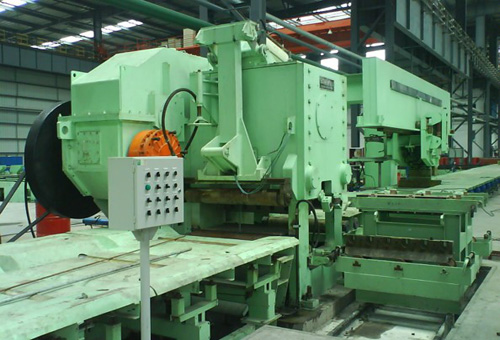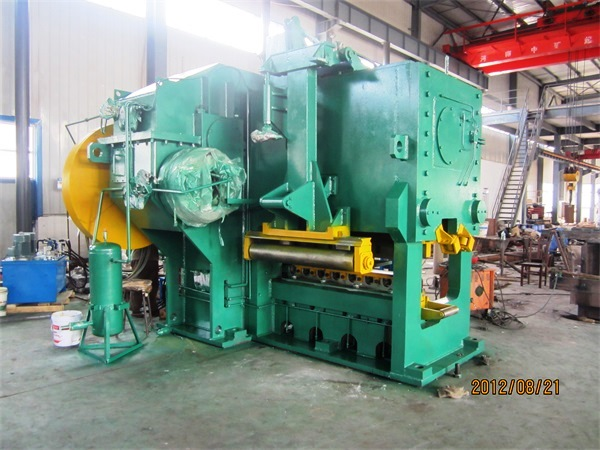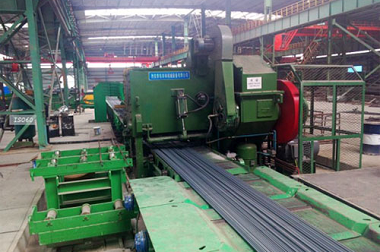12000KN Cold Shear
Introduction to Cold Shear
The 12000KN cold shear is a complete set of mechanical, electrical and hydraulic integrated equipment jointly designed and manufactured by foreign parties on the basis of absorbing the technical features of international advanced shearing machines. The cold shear is suitable for shearing small bar, flat steel and other rolled products. It runs smoothly, reliably and has flat section. Each technical index and performance are not lower than that of imported similar products and has a very high cost performance ratio. At the same time, Party B can provide high-quality spare parts in time to ensure stable and reliable operation of Party A's equipment.
Bar Specifications and Steel Grades
Shear steel: 60Si2CrVAT, GCr15, 42CrMo, 60CrMoBA, 51CrV4.
Maximum shear specification: round steel φ 60. Flat steel 53x100 (50CrV4); 40x130 (40Cr).
Main Technical Parameters
Shear force: 15000KN
Shear material: σ Bmax=1865MPa
Maximum shear material specification: φ 60
Maximum number of shear elements ( φ 60): nmax=4 ( σ B=1865MPa)
Max. flat steel size: 53x100
Maximum number of sheared flat steels: 2
Shear frequency: 20 times per minute
Shear opening: 210mm
Blade length: 1400mm
Blade inclination: 2O
Tool Installation: Flat, Forming Knives
Shear temperature: normal temperature (short term 500 oC)
Roller width: 1300mm
Drive motor: 160KW; 1500r/min. AC
Hydraulic clutch brakes (including hydraulic stations) (imported from Germany)
Grease lubrication station, about 23 lubrication points
Cutting machine outline size, length x width x height (mm) 2800x6000x4500 (mm)
The 12000KN cold shearing machine mainly consists of main motor, pulley, flywheel, hydraulic clutch brake, reducer, crankshaft, cutter frame shearing device, frame body, press device, cutter changing device, hydraulic control system, lubrication system and electric control system.
12000KN Cold Shear Structure
Belt Drive
The main motor transfers motion to the flywheel via a triangular belt (the flywheel is connected to the passive pulley) with a transmission ratio of i1=2.3. At this point, the flywheel will save energy.
Hydraulic clutch, brake and reducer
The clutch closes and the flywheel transfers motion to the reducer. When the clutch is opened, the braking function will be achieved, the reducer will stop working and the flywheel will idle. Reducer speed ratio i1=30. Hydraulic clutch brake is an imported component. Hydraulic control system is manufactured in China.
Crankshaft, shearing device
The crankshaft is mounted on the frame body with an eccentricity of 105mm. The crank cutter frame is mounted on the crankshaft and the cutter frame moves up and down in the slide of the frame body. When the clutch is closed, the reducer works and drives the crankshaft to turn. The crank holder moves down rapidly from a high position to achieve shearing (the blade is mounted on the holder via the holder). After shearing, the crankshaft tool holder moves upwards with the crankshaft rotation. When moved to high position, the clutch opens and brakes immediately. At this point, the crankshaft stalls. Wait for the next cycle. Clutch opening, closing and braking are accomplished by a proximity switch controlled hydraulic system.
Frame body and frame are door frame structures of cast-welded structure
The crankshaft is mounted in a copper alloy bushing on the frame. The tool holder is mounted in the frame body slide. The runway is made of copper alloy liners and fitted on the runway. The diagonal sliding plate has the function of adjusting the clearance between the tool holder and the sliding track, and the normal clearance is 0.1mm~0.25mm. Excessive small or large clearance will affect the quality of the section.
Blade clamping and replacement device
The blade is mounted on the upper and lower tool holders, the upper tool holder is mounted on the tool holder, and the lower tool holder is mounted on the tool holder, which is compressed by several butterfly springs. Hydraulic cylinders are installed at the rear of each group of butterfly springs. The blades are replaced hydraulically. The piston of the hydraulic cylinder pushes the butterfly spring to relax the holder and release the holder from the holder. At this point, the hydraulic cylinder piston in the frame body pushes the tool holder out half way. The knife base can be lifted out by the crane. When the new tool holder is lifted into position, the piston of the hydraulic cylinder pulls it into the tool holder position. At this point, the cylinder piston on the rear seat of the butterfly spring exits. The butterfly spring compresses the base of the blade and replaces the old and new blades.
Pressing device
Press device, which is composed of press head, lever and cylinder. Its function is to fix the shear firmly so as to achieve stable shear. Its compression is achieved by an electrically controlled hydraulic system. The position of the press material can be adjusted according to the size of the shear specification and is completed by the hydraulic cylinder.
Hydraulic system
The imported hydraulic clutch brake uses the most advanced hydraulic control system in Germany. The system controls the opening, closing and braking of the hydraulic clutch.
Blade replacement, pushing out and pulling in hydraulic system utilizing existing equipment of Party A. System pressure 12 MPa.
The hydraulic control of the press device is the same as that of the clutch.
lubrication system
Lubrication system (including dry oil pump station) is grease centralized lubrication, which mainly lubricates each sliding bearing and friction pair, about 23 points. Through the grease lubrication station, grease is fed into each lubrication point through the pipe through the distributor.
Electrical control system
The electric control system consists of a control cabinet and an operating platform. The main motor uses frequency-sensitive resistor. Each control point and process control is completed by a Siemens S7-200 programmable controller. Low voltage components are Schneider products.
Please contact stella@hanrm.com for a quotation.
And free send inquiry to us.
Email: stella@hanrm.com stellarollingmill@gmail.com
Whatsapp/Wechat:+8615877652925


















